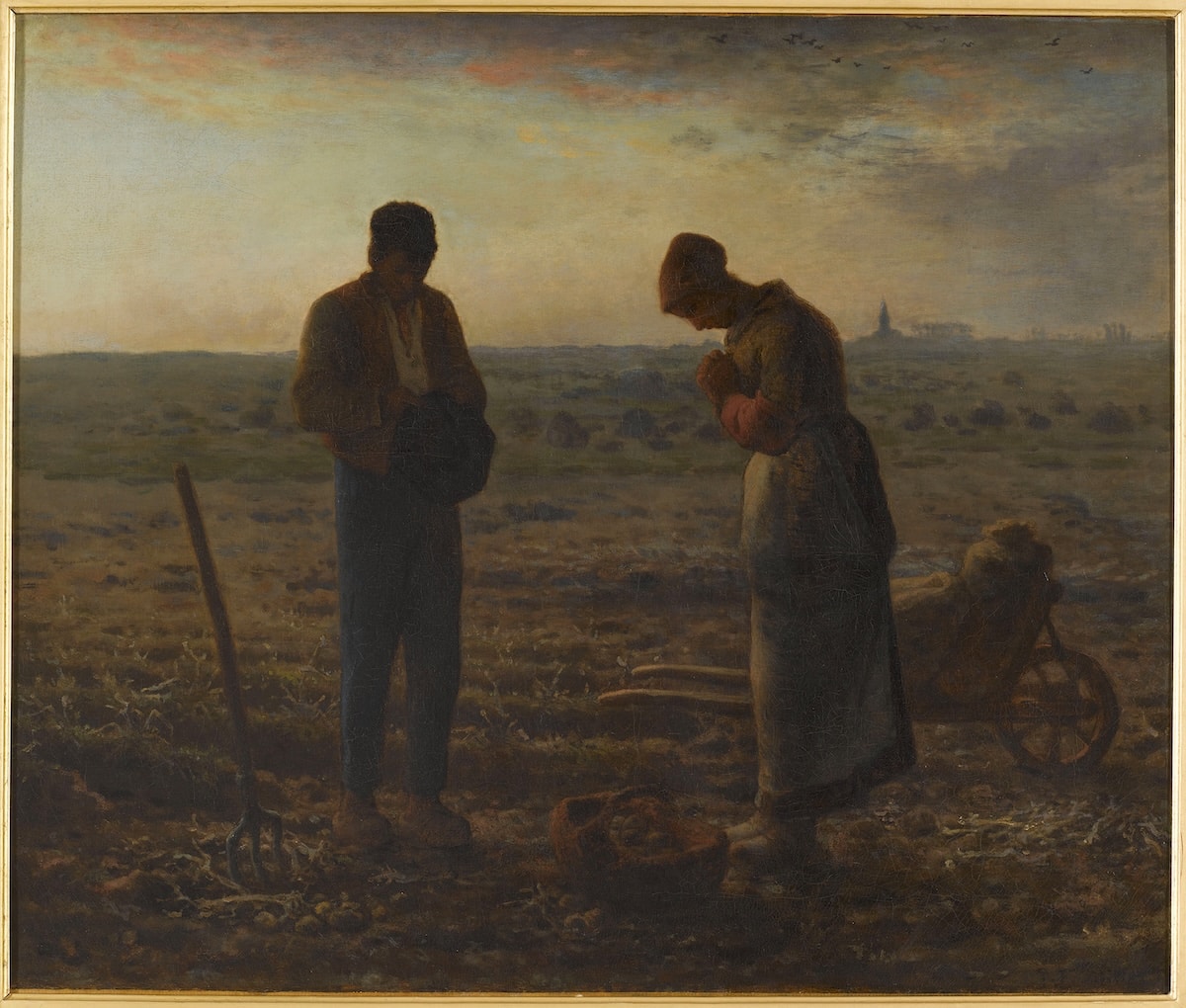The National Gallery’s dossier-style exhibitions have, in recent years, added considerably to the variety and depth of means by which the Gallery has explored aspects of its Collection. Whether addressing a particular topic such as ‘Sin’, investigating a particular painting as with ‘Discover Constable and The Hay Wain’, or, as here, focusing on a key element of an artist’s oeuvre, in this case Jean-François Millet, can add significantly to our understanding and appreciation of the Collection and the works that form it.
Jean-François Millet began his career by painting idylls in imitation of 18th-century French painters but was increasingly moved by the spectacle of social injustice. The chief example of Millet’s work owned by the National Gallery is ‘The Winnower’, a painting displayed at the Salon of 1848, the year of the Revolution that led to the downfall of King Louis-Philippe and the establishment of the Second Republic. From the following year, Millet was chiefly active at Barbizon, where he became one of the most significant painters associated with the Barbizon School of Landscape Painters.
Millet: Life on the Land ranges from his last years in Paris, the late 1840s, to the images of workers on the land that were painted during the 1850s following his move to Barbizon. This exhibition, which coincides with the 150th anniversary of his death, shows his exceptional technique, particularly as a prolific and accomplished draughtsman, while focusing on the grandeur and sense of nobility found in his depictions of rural workers as he confers on them a status which had previously been reserved primarily for figures from history.

Jean-François Millet, The Faggot Gatherers, 1868-75, Lent by Amgueddfa Cymru – Museum Wales. Bequeathed by Gwendoline Davies in 1952 (A 2478)
© Amgueddfa Cymru – National Museum Wales
The exhibition is principally structured in terms of the range of work undertaken by rural workers to highlight the fatigue associated with rural work and the precarious nature of such work, especially for workers, like wood choppers or sawyers, who owned no land of their own. Images such as ‘Wood choppers’ and ‘The Wood Sawyers’ show the physicality of that work and the wiry strength of those who undertook it. ‘The Sower’, ‘A Man ploughing and another sowing’, and ‘The Winnower’ show those involved with growing crops. In doing so, as one born into a farming family in Normandy, Millet drew on his memories of that region (as in ‘The Sower’, for example), as well as the people and work he saw in Barbizon.
Other roles depicted have a focus on women at work. These include ‘The Goose Girl’, ‘The Milkmaid’, two drawings of shepherdesses, and also wood gathering, including ‘The Faggot Gatherers’. The goose girl appears to sleep standing, supported by her staff, while the taut holding by the milkmaids of the leather straps that keep their milk jars in position on their shoulders is clearly also demanding of great strength and persistence. Gathering sticks or faggots of wood to be used as fuel for a fire was the preserve of the most vulnerable. Often left to older women in rural communities, as with gleaning, it was an activity which was heavily regulated by the authorities at the time. These images clearly show the exhaustion and fatigue associated with the physical, lengthy and demanding work undertaken by rural labourers.
It was this fatigue about which Millet commented, in a letter of 1851, when he wrote: “You are seated under the trees experiencing all the well-being, all the tranquillity that you can enjoy; then you catch sight, coming down a little footpath, of a poor figure laden with a faggot. The unexpected and always striking sight in which this figure appears before you takes you back unwillingly to the unhappy condition of mankind, to the fatigue”.
This unhappy condition, including the strenuous demands of rural labour, is also the subject of the most well-known image included here. ‘L’Angélus’, one of the most famous paintings in France and a painting that is known throughout the world, has been loaned from the Musée d’Orsay, Paris and is presented at the centre of the exhibition.
In this painting, two quiet figures, a man and a woman, are silhouetted against land and sky while reciting the Angelus. This prayer commemorates the annunciation made to Mary by the angel Gabriel. The Angelus is traditionally cited at morning, noon and evening, when it marks the end of the working day. The painting depicts the final citation of the prayer exuding, as a result, a profound sense of meditation and introspection underscored by the beauty of light.
By marking the end of the working day with a moment of stillness and contemplation, ‘L’Angélus’ shows the value to rural workers of short or snatched moments of rest. In the Angelus, Mary is invoked as an intercessor on behalf of the living and the dead and the latter – prayers for ‘the poor dead’ – was the aspect of the prayer emphasised by Millet when he wrote about his inspiration for the image. In these ways, this calm and meditative image powerfully demonstrates how Millet focuses on the ‘human side’ of his rural scenes to encourage empathy with his subjects.
When ‘The Winnower’ was exhibited at the Paris Salon of 1848, it was well received. However, later works exhibited there resulted in more extreme reactions, with some critics labelling Millet as subversive. National Gallery Director, Sir Gabriele Finaldi, also notes that Millet was sometimes accused of being a dangerous anarchist. On the other hand, many critics appropriated his work for their own progressive agenda. Both responses were, however, based on the sympathy that Millet had with the workers around him and the ‘human side’, of which he wrote in 1851, that touched him most. As Sarah Herring, Associate Curator of Post 1800 Paintings at the National Gallery, says, ‘Millet endowed rural labourers with dignity and nobility, depicting them in drawings and paintings with empathy and compassion.’
This is where Millet: Life on the Land primarily focuses its attention. However, the inclusion of ‘L’Angélus’ also enables helpful reflection on Millet’s interest in religion, something which, as Simon Kelly writes in the catalogue, has often ‘been marginalised in modernist readings of his avant-garde practice’.
Millet: Life on the Land, 7 August – 19 October 2025, National Gallery
Visit Here
Lead image: Jean-François Millet, L’Angélus, 1857- 9, Musée d’Orsay, Paris (RF 1877)
© Musée d’Orsay, Dist. Grand Palais Rmn / Patrice Schmidt


